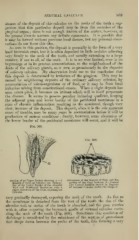Page 949 - My FlipBook
P. 949
SERUMA L CALCULUS. 959
stances of the deposit of this calcukis on tlie necks of the teeth a sug-
gestion that this particular deposit may be from the secretion of the
gingival organ ; there is not enough known of the matter, however, at
the present "time to warrant any definite statements. It is possible that
it may be formed without previous local disease, but my personal obser-
vations do not favor this idea.
As seen in this position, the deposit is generally in the form of a very
hard brownish crust, but it is often deposited in little nodules adhering
very firmly to the neck of the tooth, and usually extending to a large
number, if not to all, of the teeth. It is in no wise limited, even in its
beginnings or in its greatest accumulations, to the neighborhood of the
ducts of the salivary glands, as is seen so prominently in the deposits
of salivary calculus. My observation leads me to the conclusion that
this deposit is determined by irritation of the gingiva?. This may be
caused by neighboring deposits of the ordinary salivary calculus, by
accumulation of micro-organisms or of food, or it may be from local
irritation arising from constitutional causes. When a slight deposit has
once taken place, it becomes an irritant which will in itself perpetuate
the disease. It seems to possess peculiar irritating qualities, keeping
the adjacent gum and lower border of the peridental membrane in a
state of chronic inflammation resulting in the continued, though very
slow, increase of the deposit. This deposit, when it is the sole apparent
cause of trouble, may be many years in accumulation before if will be
productive of serious conditions ; finally, however, some ulceration of
the lower border of the peridental membrane will occur, and it will be
Fig. 50S.
Section of an Upper Incisor showing at n a Absorption of the Septum of Bone and Re-
Deposit of Seriuual Calculus and Destrnc- cession of the Gum between the Central
tion of the Lower Border of the Alveolar and I-ateral Incisors caused by Deposits
Wall and Peridental Membrane, with a of Serumal Calculus under the Gingiva.
slight Recession of the Gum, exposing the
Calculus.
very gradually destroyed, exposing the neck of the tooth. As fast as
the"^ membrane is detached from the root of the tooth the rim of the
alveolar wall or socket of the tooth is absorbed, and the gum recedes
with it, often exposing the brownish girdle of serumal calculus encir-
cling the neck of the tooth (Fig. 508). Sometimes this condition of
shrinkage is manifested by the subsidence of the septum of gum-tissue
that drops down between the necks of the teeth, this forming a very


